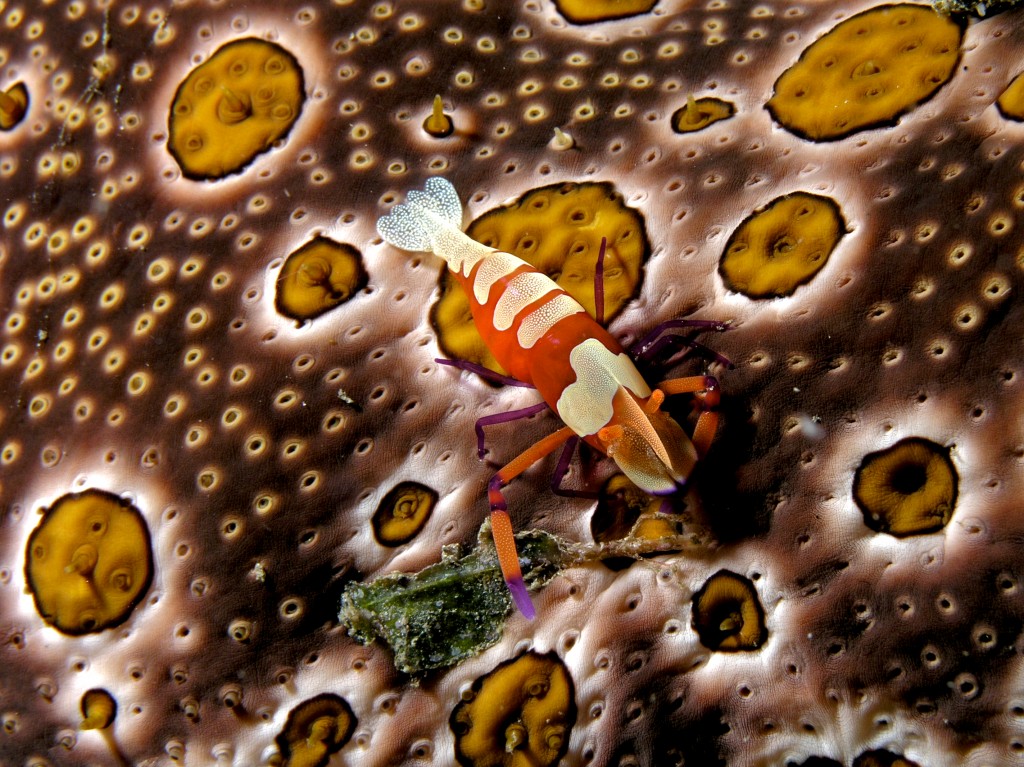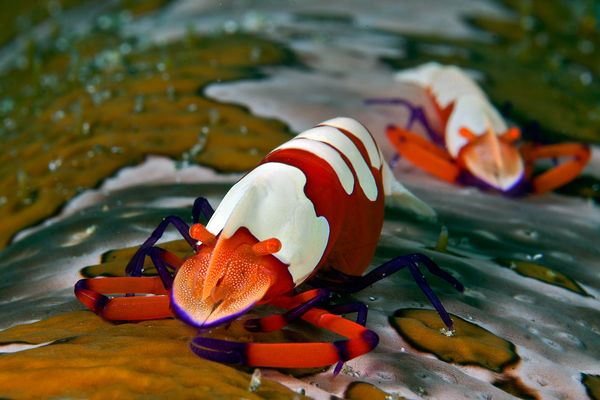The Emperor’s Shrimp (Periclimenes Imperator)
The Emperor’s Shrimp – Periclimenes imperator

Periclimenes imperator (Emperor shrimp) on Bohadschia argus (Sea cucumber) via http://en.wikipedia.org
One of the coolest thing about this hobby is its diversity in tank inhabitants. This is sadly its biggest problem as well. Due the the immense diversity, we have so many animals to choose from that we cannot know every fact about them all, which leads to purchasing something that may either kill everything or be killed. A great example of this is the Emperor’s Shrimp. These are very particular animals and have very specific living requirement.
In nature, these shrimps are found hitching rides on sea slugs and holothurians and feed on their fecal matter and detritus. Without these juicy rides, the shrimps cannot be happy and will most often hide in the rocks until they starve to death. Your aquarium MUST have a slug or you can NOT have an Emperor’s Shrimp.
Due to the tiny girth of this invertebrate, they require and benefit from minimal space. A two gallon tank is plenty of room for this guy. The only draw back of course is the need to keep the tank both stable enough for the symbiotic slug and of course keeping the slug happy with his own food source. A dead slug can nuke a 2 gallon very quickly. When keeping the Emperor’s Shrimp, you are really keeping a slug who is caring for the shrimp.
Feeding these shrimp is fairly easy. Slugs eat a variety of things depending on your species. Keeping algae in the tank and making sure there is plenty of detritus for him will be more than enough to poop out the shrimp’s lunch. If your tank is not quite stocked with slug food, supplementing it with store bought food can help. Algae based foods are good for them. Usually they won’t mess with it until it’s been sitting for a while.
Illness in shrimp is still a fairly unknown subject. Thus far, shrimps only real causes of death are starvation, water quality, or acclimation issues. They are not known to have harmful (to shrimp) parasites, but can easily carry ich from one tank to another simply by having a surface area and small crevasses that ich can easily squeeze into, along with other parasites. Of course, quarantine will prevent this from happening. There are isopods that can kill shrimp by infecting their gills, but this is not very common. It is safe to say there are things that will kill shrimp without us knowing.
Like all crustaceans, these guys do need calcium. No more than your average water change supplies, but if you use an ATS with no water changes you MUST be dosing appropriate amounts. They absorb the calcium into their exoskeleton, which is not a fast process. During molting times they will be vulnerable to predation if they are in a tank with fish or other crustaceans because of the odor produced during this process. They also require at least a low photosynthetic light to allow their bodies to utilize important elements, kind of like how people need sun light to process Vitamin C. When a shrimp molts, it will eat part of its shell to use some of the nutrients its body just lost. Leave the shell in the water. It will be gone before you know it. Like all molting creatures, death is a possibility. During the “undressing” they can get stuck, the shell can prevent them from breathing and reduce O2 levels in their body. A leg or claw can easily be ripped off, however they usually grow back within 1 or 2 moltings. In a tank with no predators this is fine, but sometimes this can be dangerous if the shrimp cannot swim full speed away from its threat.
Tank mates for these animals is fairly simple. Most reef safe fish can live with this guy, as long as shrimp is not in their diet. Make sure to research what your fish is capable of before putting them in the same tank. The obvious predators would of course be Puffers, sharks, rays, triggers, groupers, lionfish, and any other fish that requires a few crustaceans every once in a while. Even larger dottybacks can eat a freshly molted shrimp.
Invertebrates are a bit trickier to match up. Crabs are the worst with being friendly, hence the name CRAB! They have no specific diet, and eat whatever and whenever they can. They also benefit from other crustacean’s molted exoskeleton and will kill the shrimp to get to it. Keeping snails rather than crabs is more safe. Porcelain crabs or small hermits are also less of a risk. Anemones can eat shrimp, especially the notorious Condylactis which many people are unaware of its hungry nature and lack of symbiosis. The carpet anemone is also a very dangerous to shrimp species. The shrimp for some reason get drawn to these creatures only to be devoured. These shrimp can live in pairs or by themselves with ample food. They may cannibalize each other if underfed, like all shrimp.
No aquarium is equal, and not every aquarium can handle one of these guys. If your tank is mature, stable, supports sea slugs or cucumbers, then just maybe you can be successful with an Emperor’s Shrimp…but just maybe. These are very fragile, tiny, and easy to lose in a big tank. The Emperor’s Shrimp is truly a sign of success and can be an amazing addition to an already awesome aquarium. This shrimp is extremely uncommon to own, or even know someone that owns one. Getting specific help may be a chore, please attempt to get help before you try an Emperors Shrimp here in the Invertebrate forum: Invert Forum Discussion


Leave a Reply
You must be logged in to post a comment.